Welcome to “Keeping a Watch on Doomsday Clock,” our column dedicated to annotating the first ever DCU/Watchmen crossover that most of us probably didn’t need but is here nonetheless! Since this 12-issue maxiseries relies so heavily on “Watchmen,” a comic that has a ton to unpack in itself, there are a lot of details and references to look at. Something to take note of is that since the last issue of “Doomsday Clock” came out, the real-world Doomsday Clock has moved 30 seconds closer to midnight. Now it stands now only 2 minutes to destruction.
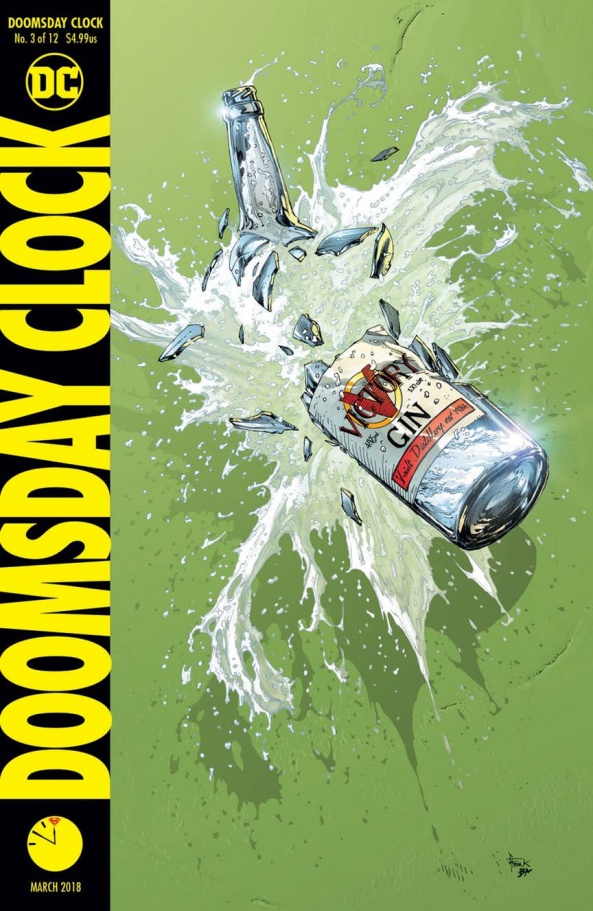
The cover shows a bottle smashing against a wall. It’s a bottle of Victory Gin from Veidt Distillery, founded in 1984. This is a reference to George Orwell’s famous novel 1984, in which Victory Gin is a common drink. Both 1984 and “Watchmen” are some of the best known dystopian classics ever published. Both also depict the 1980s as a decade characterized by war or threat of war between superpower states. Again, the idea of the cover being the first panel is followed only in a loose sense, as the first panel is nearly the same image as the cover but in different colouring.
We see Adrian Veidt committing the crime that set off the events of “Watchmen” by throwing The Comedian out of the window. The difference is that before Comedian hits the ground, the black bars indicating Dr Manhattan’s teleportation powers appear and Comedian ends up falling into the sea in the DC universe. Comedian makes it to the shore near Metropolis, where Dr Manhattan (who we only see the legs of) greets him. Comedian’s smiley face pin drops on the sand. The question of how the pin ended up in the Batcave is still unanswered, but the most likely bet is that Dr Manhattan placed it there after these events. Considering this sequence, Comedian wasn’t so much resurrected from the dead than prevented from dying. This creates quite a time paradox since if the event that set off “Watchmen” never happened, the whole story never happened, at least in the form it was originally presented. This definitely messes up “Watchmen” in a big way, but could be averted with certain storytelling tricks. If, for example, Comedian died in the DC universe later in the story, Dr Manhattan could teleport his body to the street where it was originally found.
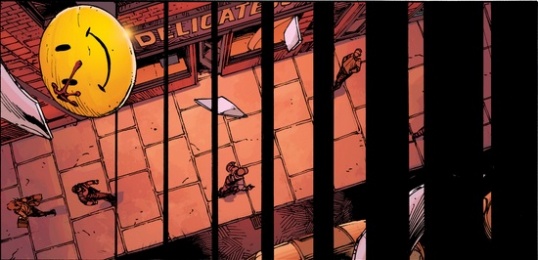
In “Watchmen” there is also a scene where a character drags himself onto the shore after having a near-death experience. It is in the ‘Tales of the Black Freighter’ comic, where a mariner survives a shipwreck but still suffers a horrible fate. This pirate tale ran as a story within a story starting in “Watchmen’s” third issue, adding new layers to the main story. Here in “Doomsday Clock’s” third issue Geoff Johns and Gary Frank begin their own story within a story, which was already hinted at in the previous issue. It’s probably the most interesting new element introduced in this issue, but before delving into it we need to take a look at what the other characters are up to.
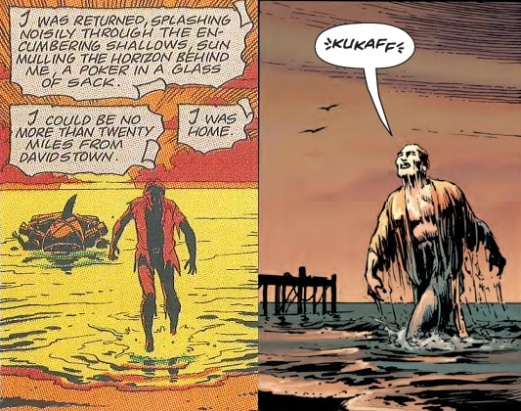
In the Batcave, Rorschach reveals that his family died in the New York massacre and hands Batman Walter Kovacs’s journal. We see that by the time this comic takes place, Batman has gotten a costume update. The logo is a new version of the yellow oval, with a thick black outer rim similar to Michael Keaton’s Batman or the last pre-Flashpoint batsuit. Superman is getting his red trunks back in “Action Comics” #1000, but Batman’s future look is still trunk-less. When this future takes place exactly isn’t so clear anymore as the “Doomsday Clock” publication schedule has changed to being published every other month, with the two skip months still in place. Originally the publication would have taken just a bit over a year; in this time, a year would’ve passed in the DC universe and all the other series would’ve caught up to the situation in “Doomsday Clock.” With the new schedule, the miniseries will conclude in mid-2019, which doesn’t fit the “one year into the future” idea unless the passing of time in the DCU is slowed down.
Continued belowWe also see more of the amusement park from “The Killing Joke” when Marionette and Mime leave the owlship. There’s some very heavy Joker foreshadowing going on here, especially in the panel with the animatronic clown and dialogue about jokes. Marionette comments that they aren’t in Jersey anymore. Actually they are in New Jersey, just in a different one than their own, since Gotham City is usually located in New Jersey.

Inside a nursing home, some elderly inhabitants are watching TV news about The Supermen Theory, which was introduced in the previous issue. In addition to Metamorpho and Man-Bat, Sondra Fuller aka Lady Clayface has now come forth about her connection to the government too. Johnny Thunder, who we saw in the nursing home in “DC Universe Rebirth” #1, is looking out of the window, waiting for his relatives to take him out for the evening. The old lady complaining about superheroes names a few men who she thinks are the real American heroes: Teddy Roosevelt, Frank Rock and Joe DiMaggio.
Roosevelt is, of course, the 26th president of the United States. Frank Rock is better known as Sergeant Rock, the main character of a DC war comic of the same name. Joe DiMaggio is one of the most famous baseball players in history. A man talking with her wants to add Carver Colman to this list, but according to the woman Colman was “a deviant.” Carver Colman was mentioned in the previous issue of “Doomsday Clock” too, in an advert for movies about private investigator Nathaniel Dusk. Colman played the titular role in these movies until his violent death. Nathaniel Dusk was the name of an actual but now largely forgotten DC character, who starred two mini-series in the 1980s. The character has now made a comeback, albeit as one who is fictional to the characters of the DC universe.
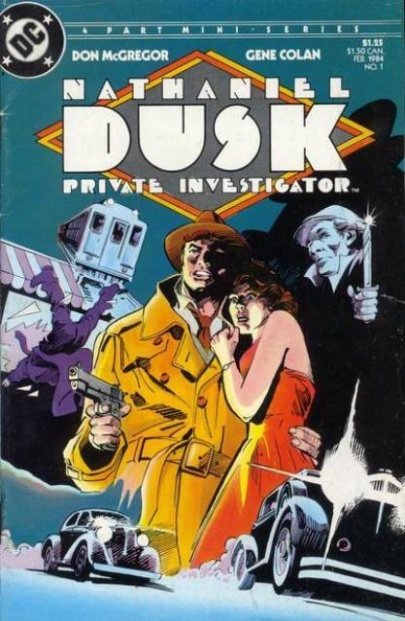
The old man arguing in Colman’s defence turns to a channel broadcasting the final Nathaniel Dusk movie, titled The Adjournment. At this point, it’s easy to guess that this will be “Doomsday Clock’s” story within a story. The plot is that Dusk is a cynical private eye who has lost his family, and is now asked to investigate a double murder on Christmas Eve. It’s not evident yet how this relates to the comic’s main story, besides some superficial visual or verbal parallels in the transition panels between them. After a while the movie gets interrupted when the channel is switched to news. The news broadcast tells about a possible attempt to create metahumans by the German government. The German superhero The Wild Huntsman is a reincarnated German warrior and a member of an international team called the Global Guardians.

At Wayne Manor, Rorschach takes off his mask in a guest bedroom, revealing a young and worried-looking face. In the shower he scrubs his head to the point of bleeding. This coupled with his earlier talk about dirtiness could point to him having some issues with cleanliness. We still don’t know much about him except that he is a young man named Reggie, most likely in his twenties, whose parents were killed in Veidt’s squid attack. He is a quite messy person with misplaced stuff and a lagging watch.
Even though he goes along with Veidt’s plan, he doesn’t trust him for quite obvious reasons. He doesn’t trust Batman either, believing him to be a possible killer, but accepts his and Alfred Pennyworth’s hospitality with caution. We also don’t know how he obtained Kovacs’s journal, which was stolen from the hands of its previous possessor Seymour David’s dead body. If he was the one who stole it, he might have also killed David. Later on as Rorschach sleeps, he is having a nightmare flashback to driving a car during the fake alien attack. He still lived with his parents at the time. There is a Bubastis toy hanging from the rear-view window of the car, indicating he was positive enough towards Veidt at the time to have his merchandise.

Marionette and Mime arrive in a Gotham bar called Jumping Jack’s, which seems to be a new creation for this series. A stand-up comedian gets a bottle smashed onto his head, echoing the issues cover and opening scene. The bar is on Joker’s turf and filled with his henchmen, adding to the already strong Joker foreshadowing of the issue. The scene is coloured in purple and green hues, too. Mime’s invisible weapons turn out to be just as lethal as actual weapons. At one point his other gun becomes slightly visible, indicating the weapons are actual objects and not just a manifestation of some sort of powers. We’ll still have to wait for the exact details of how this works and whether he actually does have some metahuman powers. After defeating Joker’s henchmen Marionette and Mime decide to seek him out and confront him directly.
Continued belowBatman tells Rorschach he has read the journal and pinpointed Dr Manhattan’s location to be at Arkham Asulym. Their visit to Arkham turns out quickly to be a hoax on Batman’s part as he locks Rorscach into a cell. The “We’re all mad here” phrase carved on the wall is a quote from Alice in Wonderland and has appeared in Batman comics before, usually in Mad Hatter stories. The issue’s ending quote if from president Theodore Roosevelt, who was also mentioned by an old lady in the nursing home. This quote’s meaning relating to the story perhaps isn’t as clear as the Ozymandias poem from issue one and the nostalgia quote from issue two. It could represent the views of Ozymandias, who was ready to make humanity suffer a great tragedy to save it as a whole and make his vision of the future come true.
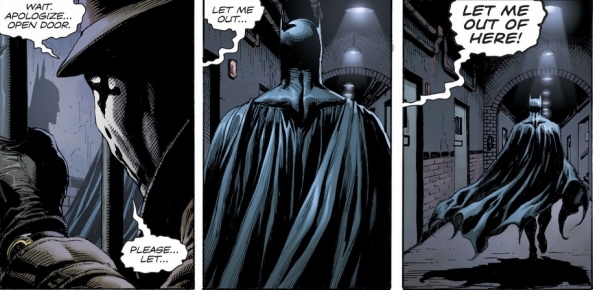
The attached document is a gossip rag called ‘Screenland Secrets.’ The main article inside tells about Carver Colman, but first let’s take a look at the other names mentioned on the cover. Norma Desmond is not a DC character, but a character from the 1950 film noir Sunset Boulevard. Jackie Johnson belonged to DC’s Sergeant Rock’s Easy Company. Sgt Rock was mentioned earlier in the issue, and Randy “Tin Soldier” Booth, another member of Easy Company, is mentioned later in the magazine. Someone called Frank Farr, who also has starred in Nathaniel Dusk movies, has a secret love child.
While that name might not ring any bells, the article about this affair links Frank Farr to an existing DC character. According to ‘Screenland Secrets’ Farr was married to real-life actress Barbara Swantyck, one of the most famous actresses from the Golden Age of Hollywood. Their marriage was broken up when Farr had an affair with a Rachel Drake, resulting in a baby girl named Rita. Rita Farr is a member of the Doom Patrol, known first as Elasti-Girl and then as Elasti-Woman. She, herself, was a Hollywood actress until an accident that gave her the ability to alter her size. Later on, she married fellow Doom Patrol member Steve Dayton and adopted Garfield Logan, aka Beast Boy. In addition to the Justice Society of America and Sgt Rock’s Easy Company, Geoff Johns has now dropped in a reference to yet another DC team.

The main article covers the death of Carver Colman, who was found beaten to death with an award he won for one of his Nathaniel Dusk films. Many of the names dropped in this article are also real people. The article speculates that Colman’s entire personal history including his parents might have been made up. There also seems to have been some unfortunate happenings linked with most of the Dusk movies: bans, screenwriters in prison, actors dying during production. The Adjournment was only released after Colman’s death. Colman had an entire room filled with watches in his home, but the one on his wrist at the time of his death was stolen from the body. In the watch room there was also a paper revealing that his possible real mother, who was related to a crime family, had tried to blackmail him for money. Perhaps this extreme interest in watches and shady past were what the old lady at the nursing home referred to when she called Colman a deviant. “Doomsday Clock” and “Watchmen” are, of course, both filled with clock and watch imagery, but a more specific connection is that young Jon Osterman, aka Dr Manhattan, was going to become a watchmaker in his father’s footsteps.

The Verner Bros, DC’s stand-in for the Warner Bros, collected millions of insurance from Colman’s death, which remains an unsolved murder case. Bruce Nelson, who was investigating the murder, was one of the many detectives appearing in “Detective Comics” in the 1930s. The last page covers some smaller Hollywood rumours. There is more talk about Sergeant Rock’s Easy Company and a conspiracy about his death. The conspiracy is probably based on the fact that Rock’s final fate has changed so many times in the comics that it leaves his death ambiguous. Ted Grant, aka Wildcat, and Libby Lawrence, aka Liberty Belle, are mentioned. These are yet another JSA reference after Johnny Thunder featuring in this issue and Hourman and Green Lantern being hinted at in the previous one. Finally, there is a rumour that screenwriter John Law would have been a suspect for Colman’s murder. Law is the former superhero Tarantula and also the former husband of Libby Lawrence. This rumour turns out to be false as Law was locked up for driving under the influence on the night of the murder, but that doesn’t mean he doesn’t have anything to do with it.
“Doomsday Clock” #3 offered us some more information on the new Rorschach and the beginning of the Nathaniel Dusk story. The second issue was very light on the real world references, this time we got more of them again, most having to do with the Golden Age of Hollywood. A lot of stuff is still being kept behind the veil. For example, Superman hasn’t been seen after the final pages of the first issue. Come back after a month to delve into “Doomsday Clock” #4!




